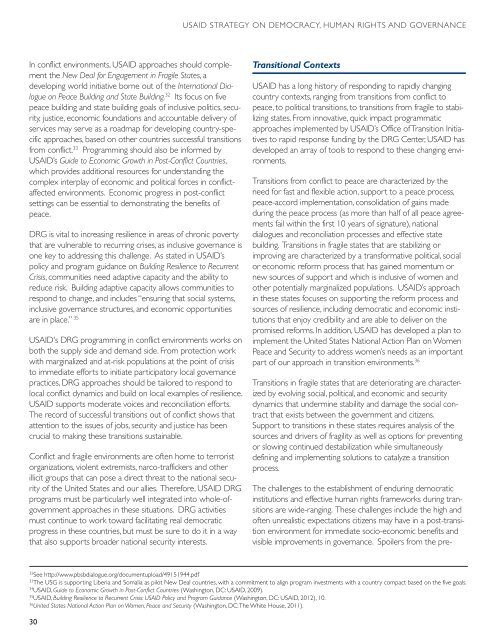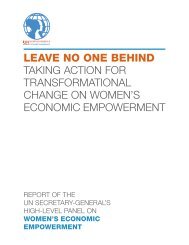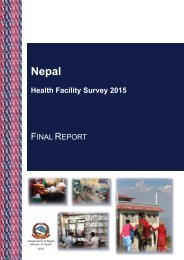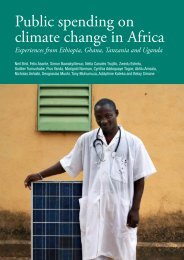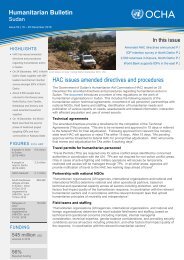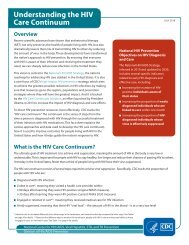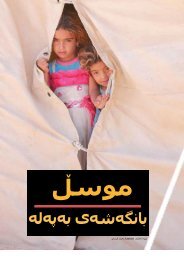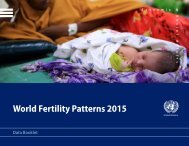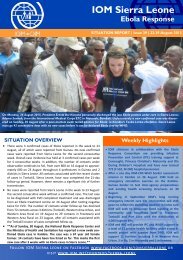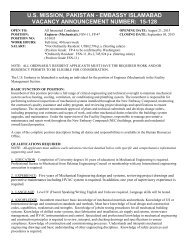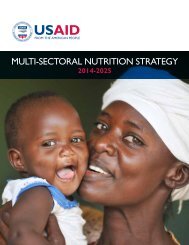USAID DRG_ final final 6-24 3 (1)
USAID DRG_ final final 6-24 3 (1)
USAID DRG_ final final 6-24 3 (1)
Create successful ePaper yourself
Turn your PDF publications into a flip-book with our unique Google optimized e-Paper software.
<strong>USAID</strong> STRATEGY ON DEMOCRACY, HUMAN RIGHTS AND GOVERNANCEIn conflict environments, <strong>USAID</strong> approaches should complementthe New Deal for Engagement in Fragile States, adeveloping world initiative borne out of the International Dialogueon Peace Building and State Building. 32 Its focus on fivepeace building and state building goals of inclusive politics, security,justice, economic foundations and accountable delivery ofservices may serve as a roadmap for developing country-specificapproaches, based on other countries successful transitionsfrom conflict. 33 Programming should also be informed by<strong>USAID</strong>’s Guide to Economic Growth in Post-Conflict Countries,which provides additional resources for understanding thecomplex interplay of economic and political forces in conflictaffectedenvironments. Economic progress in post-conflictsettings can be essential to demonstrating the benefits ofpeace.<strong>DRG</strong> is vital to increasing resilience in areas of chronic povertythat are vulnerable to recurring crises, as inclusive governance isone key to addressing this challenge. As stated in <strong>USAID</strong>’spolicy and program guidance on Building Resilience to RecurrentCrisis, communities need adaptive capacity and the ability toreduce risk. Building adaptive capacity allows communities torespond to change, and includes “ensuring that social systems,inclusive governance structures, and economic opportunitiesare in place.” 35<strong>USAID</strong>'s <strong>DRG</strong> programming in conflict environments works onboth the supply side and demand side. From protection workwith marginalized and at-risk populations at the point of crisisto immediate efforts to initiate participatory local governancepractices, <strong>DRG</strong> approaches should be tailored to respond tolocal conflict dynamics and build on local examples of resilience.<strong>USAID</strong> supports moderate voices and reconciliation efforts.The record of successful transitions out of conflict shows thatattention to the issues of jobs, security and justice has beencrucial to making these transitions sustainable.Conflict and fragile environments are often home to terroristorganizations, violent extremists, narco-traffickers and otherillicit groups that can pose a direct threat to the national securityof the United States and our allies. Therefore, <strong>USAID</strong> <strong>DRG</strong>programs must be particularly well integrated into whole-ofgovernmentapproaches in these situations. <strong>DRG</strong> activitiesmust continue to work toward facilitating real democraticprogress in these countries, but must be sure to do it in a waythat also supports broader national security interests.Transitional Contexts<strong>USAID</strong> has a long history of responding to rapidly changingcountry contexts, ranging from transitions from conflict topeace, to political transitions, to transitions from fragile to stabilizingstates. From innovative, quick impact programmaticapproaches implemented by <strong>USAID</strong>’s Office ofTransition Initiativesto rapid response funding by the <strong>DRG</strong> Center, <strong>USAID</strong> hasdeveloped an array of tools to respond to these changing environments.Transitions from conflict to peace are characterized by theneed for fast and flexible action, support to a peace process,peace-accord implementation, consolidation of gains madeduring the peace process (as more than half of all peace agreementsfail within the first 10 years of signature), nationaldialogues and reconciliation processes and effective statebuilding. Transitions in fragile states that are stabilizing orimproving are characterized by a transformative political, socialor economic reform process that has gained momentum ornew sources of support and which is inclusive of women andother potentially marginalized populations. <strong>USAID</strong>’s approachin these states focuses on supporting the reform process andsources of resilience, including democratic and economic institutionsthat enjoy credibility and are able to deliver on thepromised reforms. In addition, <strong>USAID</strong> has developed a plan toimplement the United States National Action Plan on WomenPeace and Security to address women’s needs as an importantpart of our approach in transition environments. 36Transitions in fragile states that are deteriorating are characterizedby evolving social, political, and economic and securitydynamics that undermine stability and damage the social contractthat exists between the government and citizens.Support to transitions in these states requires analysis of thesources and drivers of fragility as well as options for preventingor slowing continued destabilization while simultaneouslydefining and implementing solutions to catalyze a transitionprocess.The challenges to the establishment of enduring democraticinstitutions and effective human rights frameworks during transitionsare wide-ranging. These challenges include the high andoften unrealistic expectations citizens may have in a post-transitionenvironment for immediate socio-economic benefits andvisible improvements in governance. Spoilers from the pre-32See http://www.pbsbdialogue.org/documentupload/49151944.pdf33The USG is supporting Liberia and Somalia as pilot New Deal countries, with a commitment to align program investments with a country compact based on the five goals.34<strong>USAID</strong>, Guide to Economic Growth in Post-Conflict Countries (Washington, DC: <strong>USAID</strong>, 2009).35<strong>USAID</strong>, Building Resilience to Recurrent Crisis: <strong>USAID</strong> Policy and Program Guidance (Washington, DC: <strong>USAID</strong>, 2012), 10.36United States National Action Plan on Women, Peace and Security (Washington, DC:The White House, 2011).30


